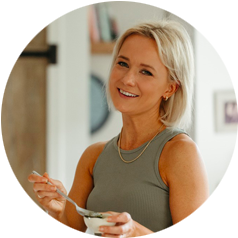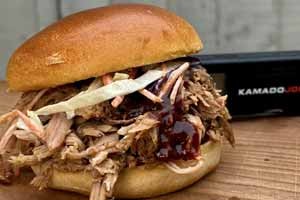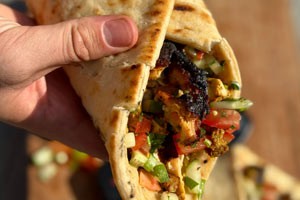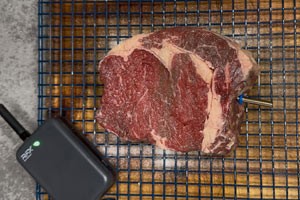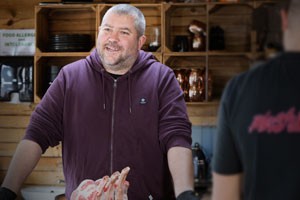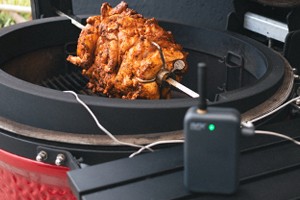Easy, tender BBQ pulled pork, loaded into buns with coleslaw and BBQ sauce.
The Culinary Cartel's Five Ways to Elevate Your Air Fryer Recipes with Thermapen
The quickest way to build confidence in the kitchen is to use tools that eliminate all the guesswork from cooking, especially when mastering your new air fryer. Air fryers are fantastic, but they don't operate exactly like convection ovens, and the familiar rules and temperatures you are used to may not apply.
While tempted to invest in a high-end sauté pan or a spend couple of hundred pounds on a Dutch oven, a temperature probe like a Thermapen can enhance your cooking skills without the need for additional fancy kitchen equipment. No more stabbing at potatoes, jiggling custards, prodding chicken, or tapping on loaves of bread and hoping for the best; simply invest in a good instant-read thermometer and follow our handy guide below.
Baked Potatoes
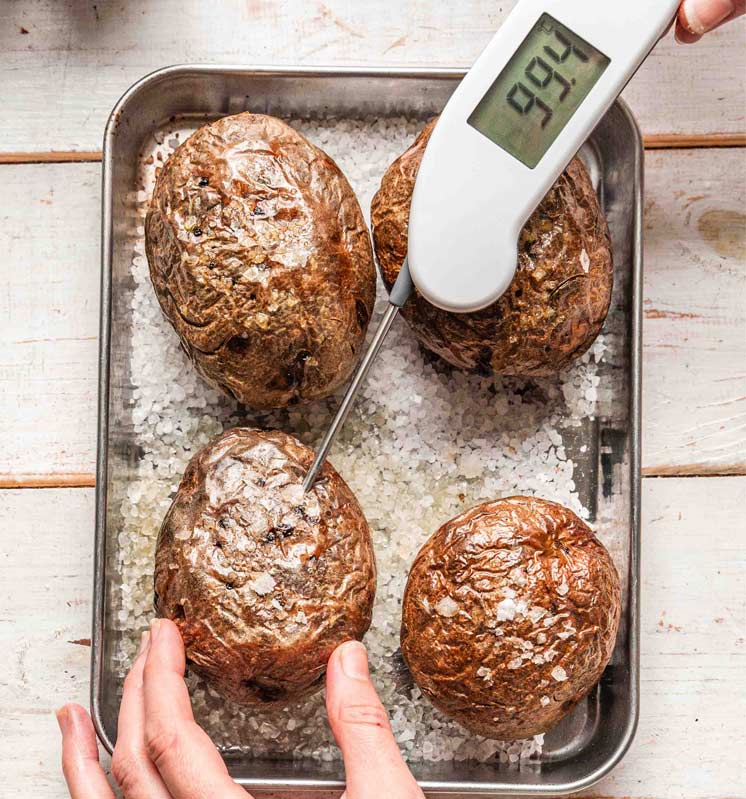
Love your jacket or baked potatoes? Whip them up quickly in your air fryer and nail them every time with a temperature gauge like a Thermapen. Potato perfection every time, no guessing, just science!
As the potato heats, the trapped moisture in the skin turns to steam, causing starch grains to rupture and create a fluffy texture. To ensure perfect fluffiness, use an instant-read thermometer to check for an internal temperature between 94 °C to 100 °C, indicating optimal starch granule absorption and softness. Below this, the potatoes will still be too dense, and above, they start to go gummy in texture.
You need a nice floury potato for jackets, so grab a Maris Piper or King Edward. Wash your potatoes and prick them with a fork. Do not drizzle over any oil yet. Grab a tray that fits into your air fryer, or remove the grill so the potatoes sit on a flat surface in the basket. Make a little pile of coarse sea salt for each potato, ensuring a good gap between each for air circulation. Pop the potatoes on top. Why a salt bed? This is going to absorb excess moisture and make the potatoes really fluffy.
Air Fryer Only
(Extra Crispy and Fluffy):
Pop the potatoes on their little salt beds into the air fryer. Cook at 190 °C for 45-50 mins.
When the centre of the potato is pierced with a thermometer, it should ideally read 94-100 °C.
Slice the cooked jackets open, and serve immediately so as not to trap the steam inside and ruin their fluffy texture. Add with your favourite toppings and enjoy.
Air Fryer + Microwave (Fast):
Before adding the potatoes to the salt bed, microwave for 6 minutes on high. Then, pop the potatoes onto their little nests of salt and place them into the air fryer for 30 minutes at 190 °C. Halfway through cooking, drizzle over some oil and season with flaked or fine sea salt to crisp the skin.
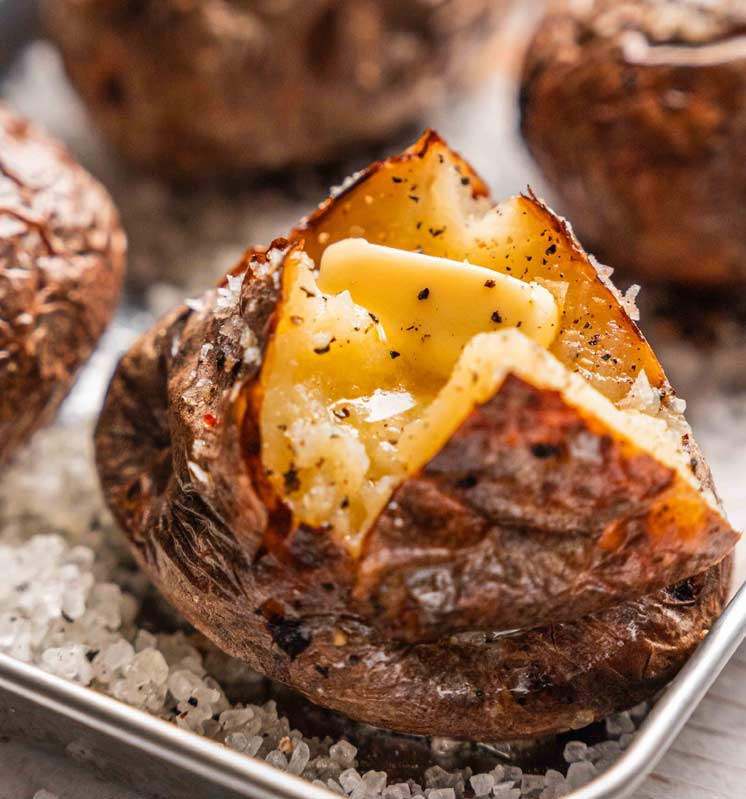
Bread
Knocking on the bottom of a golden baked loaf and listening for a hollow sound is often the anecdotal advice given to us to check our loaf of bread is perfectly cooked, but this can vary depending on the type of bread you plan to cook, plus it's hardly accurate.
Perfecting the art of baking bread in the air fryer requires precision, and a Thermapen proves invaluable — no more tapping and guessing. When converting my bread recipes from oven to air fryer format, I tend to cook them at 15-20% lower heat for the same duration ( for example, bread baked at
190 °C in an oven will be 160 °C in my air fryer). This adjustment accounts for the air fryer's more intense heat, where 190 °C in the oven differs from 190 °C in the air fryer. Generally, I find 160-165 °C the sweet spot for breads and cakes.
To build confidence, start with a recipe developed for air frying, then use it, along with your Thermapen, to adapt your favourite recipes. After a few minutes, when the bread has a light golden crust, insert the Thermapen deep into the loaf and check the temperature.
Rich-dough breads like brioche, dinner rolls, challah, or tender sandwich bread achieve perfection at 82–88 °C. Lean dough breads, including baguette, sourdough, rye bread, or Cuban bread, require a slightly higher temperature of 88–99 °C for optimal results. The Thermapen's accurate temperature readings ensure that whether you're crafting a fluffy, enriched loaf or a rustic, lean creation, your bread reaches the ideal doneness, and it won't dry out and overcook, or have a doughy bottom. I like to remove my breads at the lower end of the temperature range, as they will continue to cook for a few minutes in the residual heat after leaving the oven.
Custard-Based Dishes
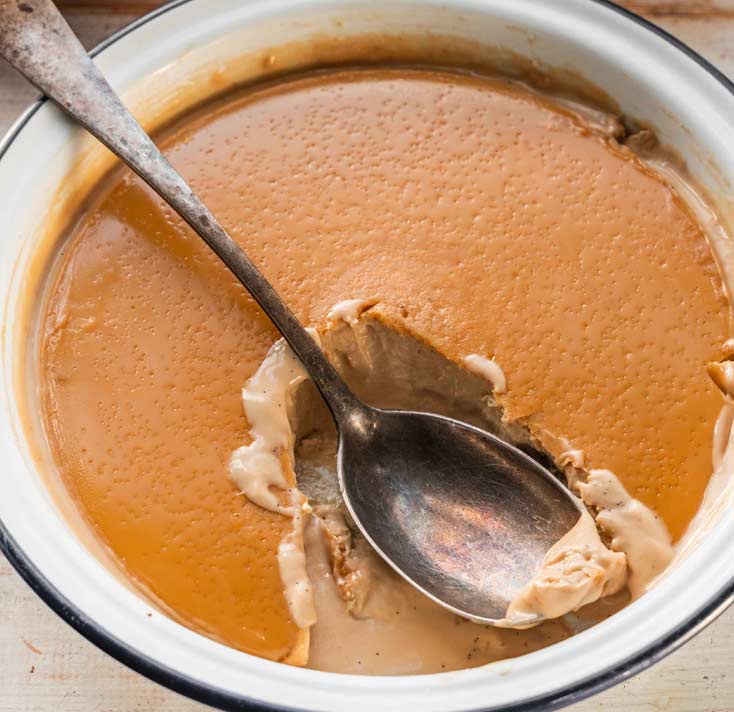
Custard-based desserts and savouries, such as quiches, are among my favourite things to cook in my air fryer. There are three basic rules for success: follow a trusted recipe, cook them at low heat so they don’t scramble, and ensure they are just set in the middle. If unsure about the desired consistency, use a Thermapen to check the temperature in the centre. The chemistry of custards involves a simple yet delicate interplay among basic pantry staples—eggs, milk/cream, and sometimes a sweetener like sugar. A perfect custard is luscious, creamy, just set, and has a smooth surface. Overcooking results in a strong egg taste and a grainy texture.
Rich custards such as crème brûlée, flan/creme caramel, and pumpkin pie, with a higher milk or cream content, should be removed from the oven at 77–79 °C. While they may seem a little jiggly once out of the oven, the high-fat content will aid in setting once chilled. For more eggy dishes like quiches and bread & butter pudding, where proteins bind with less milk, the optimal temperature is 71°C.
Chicken Legs and Thighs
Did you know chicken is one of the most popular recipe categories for air frying? The intense, dry heat is brilliant for getting the crispiest skin, but can also lead to your chicken drying out if you don’t cook it correctly. Thighs and legs are fantastic when cooked in the air fryer; they are an economical cut, and air frying is far superior to the oven in terms of achieving the best crispy skin. We all love a chicken supper, but there's nothing more disappointing than mealy, dry white meat or gummy, undercooked brown meat. As a general rule, chicken is safe to eat at 74 °C, so use your Thermapen on a few areas, especially around the thigh bone, to check that you are working within the safe zone.
What many don't know is that dark meat needs to be cooked to a higher temperature for the best results. If you don’t like dark meat because of its texture, then you aren’t cooking your dark meat to ensure optimal results. Chicken thighs and legs have more connective tissue, and this will only start to soften and break down at 77-80 °C. Remove your legs and thighs from the oven once you hit this temperature, then allow the chicken to rest in a warm spot, where the meat will rest and continue to cook, reaching 83-85 °C, depending on the size of the cuts. The result is tender, succulent brown meat, with a lovely crispy skin.
Garlic Confit
This might be something you've probably seen all over social media, but it's far from a fad gimmick. I love keeping a jar of garlic confit in my fridge to add here and there into marinades, dressings, and sauces. Plus, honestly, it makes the best garlic bread, and what's better than that?
Garlic confit has a deep umami flavour due to the slow, gentle cooking process it undergoes. Confit is a French cooking technique that involves slow-cooking food, usually meat, in fat or oil at low temperatures. Here, we apply it to garlic, producing a versatile condiment that will elevate any recipe you add it to. As garlic cloves are submerged in oil and cooked at a low temperature over an extended period, the harsh and pungent flavours of raw garlic transform into a mellow, sweet, and nutty profile. The slow infusion allows the garlic to soften and caramelise, enhancing its natural sweetness and creating a velvety texture. Store in a glass jar in the fridge, covered in its cooking oil, where it will last for two weeks, or for two months in the freezer. Smush the cloves into seasoned yoghurt for an easy sauce for chicken or dressing for a salad or wrap. Spread the cloves on toast and top with goat's cheese, or serve the cloves in oil alongside a cheese board; the options are endless. Don't neglect the oil; use quality olive oil and use the garlicky oil to finish roasted veg, to make dressings, and finish grilled meats.
Here's how to do it. Break up a head or two of garlic into a bowl. Pour over boiling water to loosen the skins. Peel all the garlic cloves, pop them into a snug oven-safe dish, and cover with good olive oil. Add flavourings if you like, like fresh thyme, rosemary, whole peppercorns, or a bay leaf, then place it into the air fryer at 110 °C for 1-1.5 hours until the cloves are completely soft. The trick is to keep the oil around 90-100 °C for best results, so use your Thermapen to check the temperature as you go, adjusting the head of the air fryer as necessary. Remember the temperature you set for the air fryer as it will vary slightly from the temp of the oil, so using your Thermapen will allow for more accuracy.

"I'm Jess, the creative mind behind The Culinary Cartel. I specialise in modern and accessible recipes for those who love to create delicious food but have limited time to cook. The Thermapen has become an indispensable tool in my kitchen, eliminating guesswork and bringing precision to every dish. Not only does it ensure consistency in my recipe testing, but it also empowers my audience to replicate the same
fantastic results."





